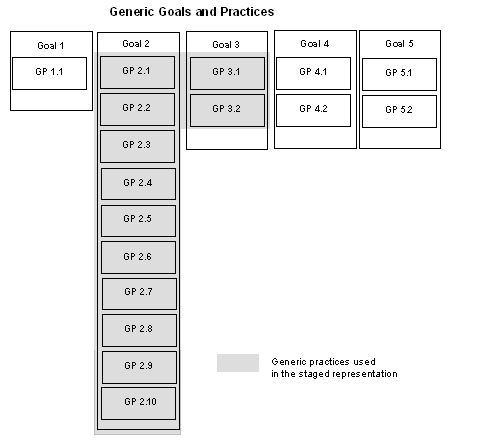Generic goals are required model components that apply to all process areas. Figure 3.3 illustrates the generic goals and practices. All of the generic goals and practices are used in the continuous representation. (See the Generic
Goals and Generic Practices section on page 75 for a more detailed description of generic goals and practices.) The capability level you are targeting for your improvement effort will determine which generic goals and practices you will apply to the
process area you have selected.

Figure 3.3: Generic Goals and Generic Practices
In the staged representation, only generic goals 2 and 3 are used, as illustrated by the generic practices highlighted in gray in Figure 3.3. When you try to reach maturity level 2, you use the process areas at maturity level 2 as
well as generic goal 2 and its generic practices.
Notice that generic goals 4 and 5 and their associated generic practices are not used. This is because not all processes will be “raised” above (i.e., matured beyond) a defined process. Only select processes and subprocesses will be
quantitatively managed and optimized, and which processes and subprocesses are selected is addressed by the process areas at maturity levels 4 and 5.
When you reach maturity levels 3, 4, and 5, you use the process areas at the appropriate maturity levels as well as all of those at the lower maturity levels. In addition, generic goal 3 and its associated generic practices (which
include the generic practices associated with generic goal 2) are applied to all of these process areas. This means that even though you have already achieved a maturity level 2 rating, to achieve a maturity level 3 rating you must return to the
maturity level 2 process areas and apply generic goal 3 and its generic practices as well.